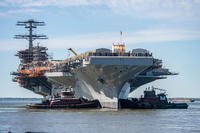WASHINGTON -- Naval Facilities Engineering Command (NAVFAC) Washington awarded a $27.9-million Energy Savings Performance Contract (ESPC) to Clark Energy Group, Sept. 25, to reduce energy consumption and save associated costs at Naval Air Station (NAS) Patuxent River.
The project will implement five different energy conservation measures across 72 buildings at the Air Station's Webster Outlying Field, including upgraded lighting, ground source heat pumps, water conservation measures, thermostats and controls replacement, and building envelope upgrades, said Naval District Washington (NDW) Energy Director Lt. Cmdr. Keith Benson.
"This project will significantly reduce energy use at Webster Outlying Field and is the first of 27 ESPCs worth $750 million to be awarded by the U.S. Navy over the next two years around the world," Benson said. "This is part of the energy portfolio strategy that will help reduce energy intensity and ties directly to the SECNAV [Secretary of the Navy] energy goals and the executive orders that are in place."
An ESPC is a contract between a federal agency and a Department of Energy (DOE)-approved energy services contractor, or ESCO, that provides financing and equipment for energy projects, and is paid through energy, water and maintenance savings by the projects installed.
"ESPCs guarantee energy savings - that's really the key with these types of contracts," Benson said. "Each year as the savings are measured and verified, the U.S. Navy will repay the ESCO investment out of the energy, water and maintenance savings that are guaranteed."
"The project was made possible by a partnership between NAVFAC Washington, NAS Patuxent River and the Naval Air Warfare Center (NAWC) Aircraft Division" said Capt. Tony Edmonds, commanding officer, NAVFAC Washington. "Most of the buildings involved belong to NAWC, so they were the ones who made the biggest investment and who will benefit most from the savings", Edmonds noted.
Cmdr. Alex Moore, public works officer at NAS Patuxent River, said the station public works department will provide quality assurance oversight of the project and verify savings made after upgrades have been installed. According to NAVFAC Washington's ESPC project manager, Mr. Charles Heyward, "during project development, the Team (ESCO, NAVFAC, DOE and NAWC) examined in detail the performance of the existing system or fixtures against the engineering requirements of the proposed ECM [energy conservation measure]. This also included examining the performance, maintenance, repair/replacement, measurement, and verifications requirements."
Now that the contract has been awarded, the 22-month construction phase of the project is set to begin shortly.
"We expect to reduce the annual utility and maintenance costs by over $800,000," said Moore, who noted that much of NAS Patuxent River's expenses result from energy usage. After the ESPC project is complete, the energy conservation measures will reduce the energy consumption in the associated buildings by 38 percent, he added.
"[The ESPC] provides better and easier-to-operate equipment," Moore said. "It's going to improve controls to make the system more efficient in reducing energy here."
Benson said replacing fossil fuel oil-run boilers and chillers with electric ground source heat pumps will provide the majority of the savings at Webster. As this ESPC begins the construction phase of the project at NAS Patuxent River, Benson said other upcoming ESPCs are already in the planning stages for other installations within NDW that will further help achieve the Navy's energy goals.
"ESPCs are another contract tool in addition to our existing contract vehicles that we will use to reduce energy and water intensity throughout Naval District Washington... and we are beginning to see positive results from the combination of efforts," he said.



























